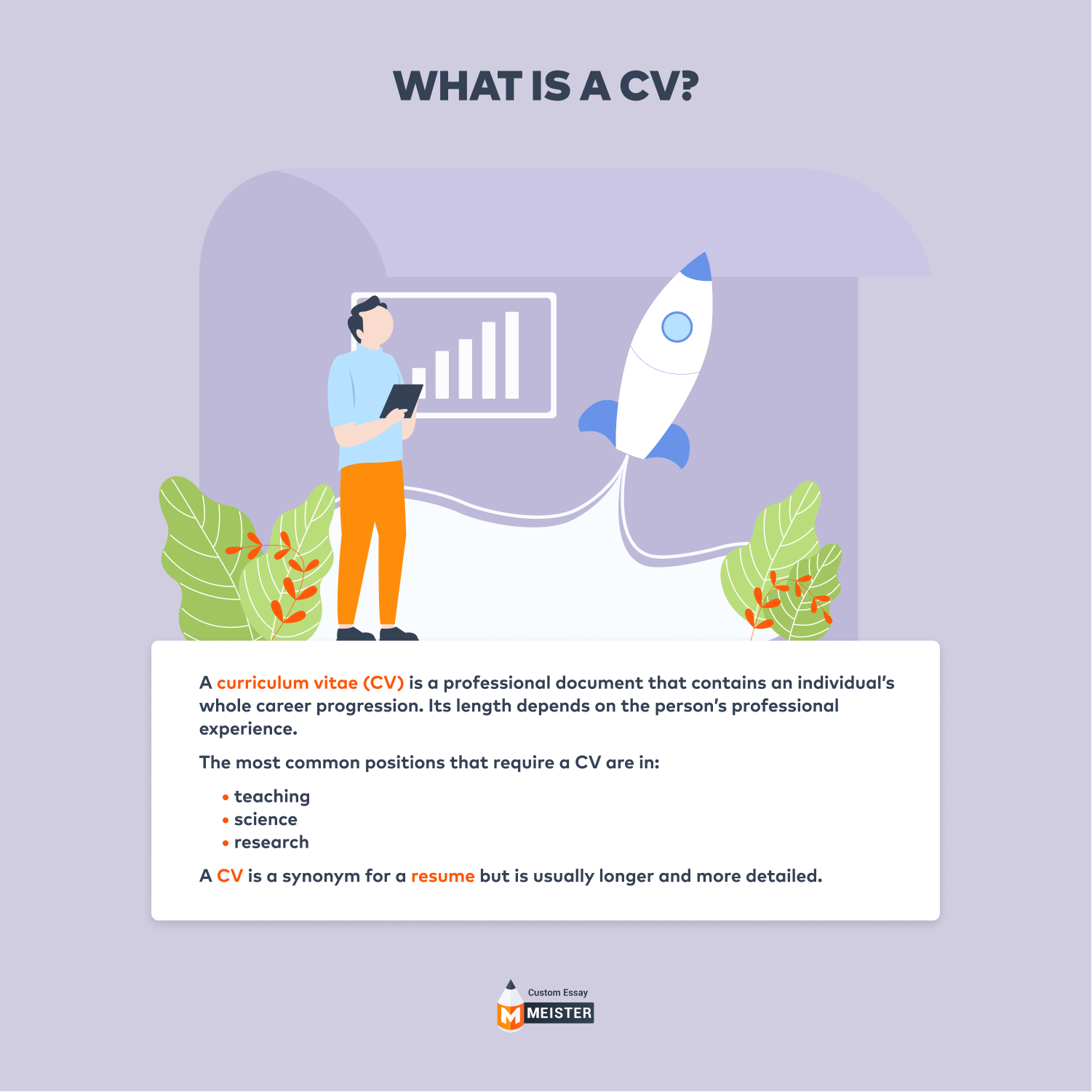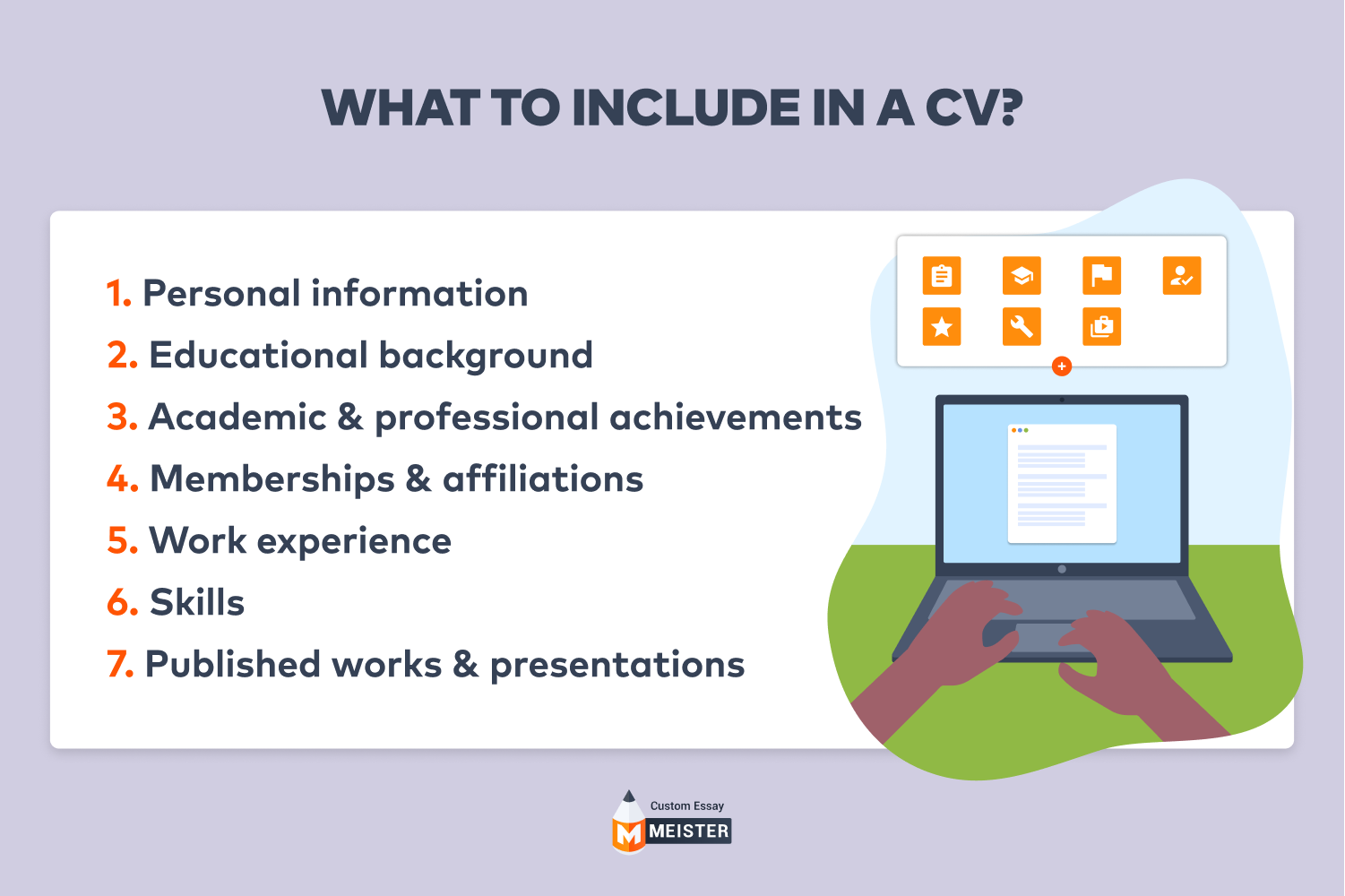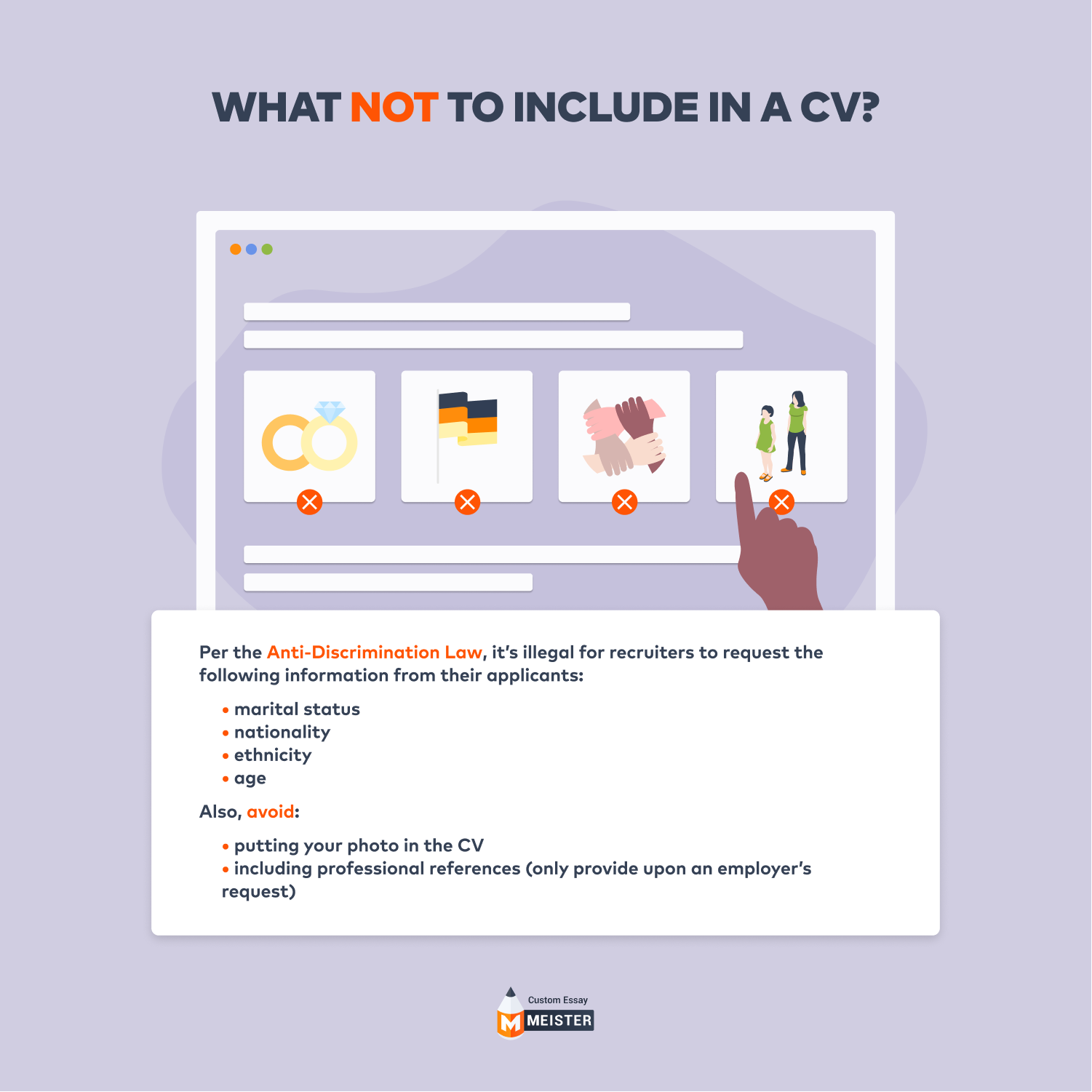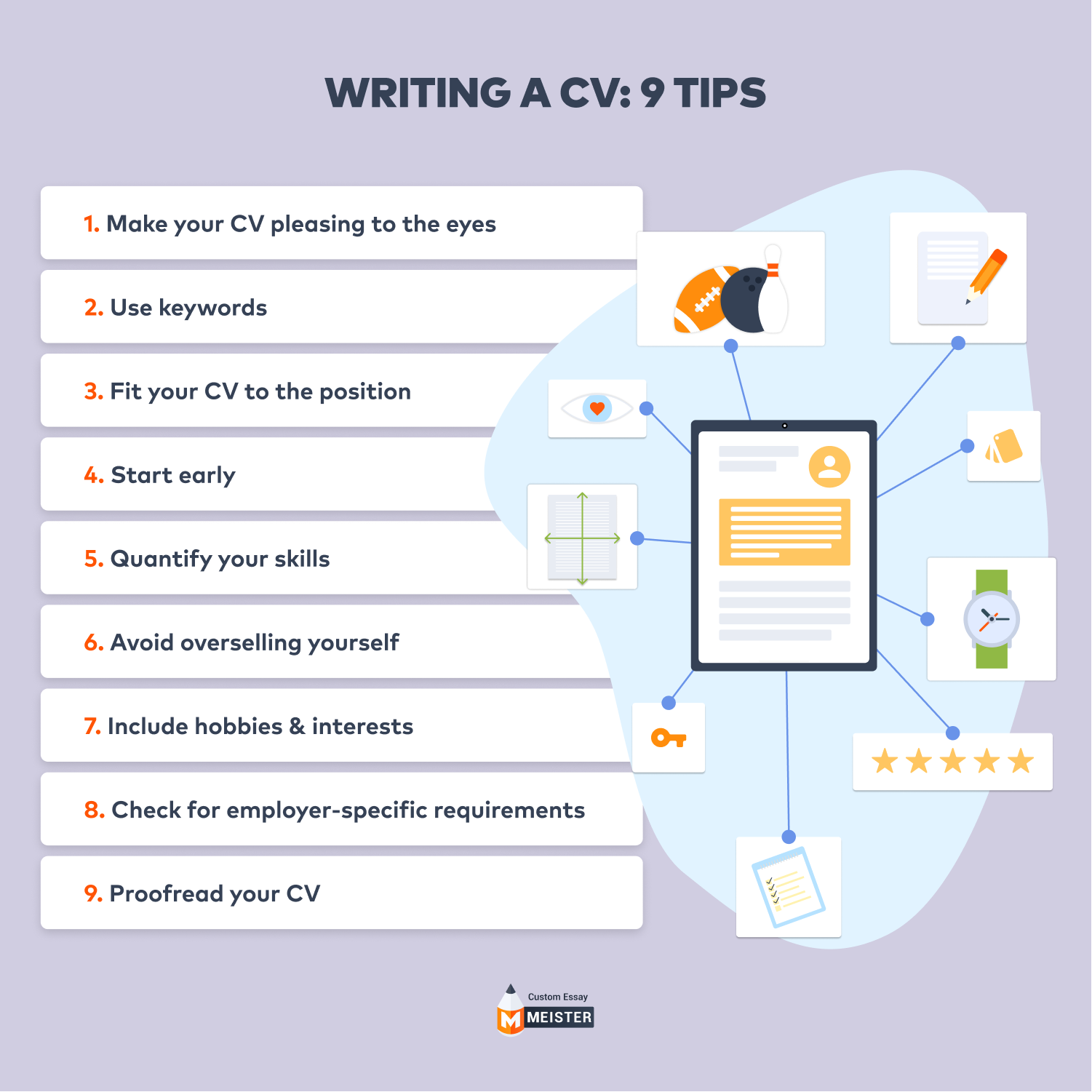How to Write a Curriculum Vitae (CV): Samples, Templates, and Writing Tips
A curriculum vitae, or CV, is a professional document that contains an individual’s whole career progression. It can be a lengthy document if the person writing it has a lot of work experience and marketable skills. Teachers and scientists are the most common professionals who use a curriculum vitae for a job application. The nature of their fields requires them to showcase most of their experiences and skills before employers consider their job applications.
Writing a CV might be confusing for people who are starting with their careers or professionals who are considering changing their work industry. Students who are writing research papers may also find themselves writing a CV to add at the end of their paper. It is easy to confuse a curriculum vitae and a resume. Some countries even use the term CV as a synonym for resume. That is why knowing the definition of the term should be the first step in writing one.
What Is a Curriculum Vitae?
A curriculum vitae, or CV, is an information-filled document that contains the whole career history of a person. Similar to a resume, it includes a person’s work experiences, skills, educational background, and career achievements. However, the contents inside the document are more detailed and contain qualifications that a professional will not normally include in a resume. These can be published works, organizational memberships, and professional references. A CV can be a very long document that is five or more pages.

Professionals in the education and scientific fields are the individuals that need to know how to make a CV. This is due to the academic nature of their fields. Institutions require them to submit a CV that will highlight all of their qualifications and provide evidence of their previous works. However, a fresh graduate who is applying in these types of fields will also need to submit the document. It will be difficult since they have no prior experience to include in the document.
It is also important to note that the definition of CV changes depending on the country. Around the US, a curriculum vitae is a document containing an individual’s whole career history. In Europe, a CV is synonymous with a resume. They use the term when submitting any document for a job application. In some Asian countries, employers often ask for a resume or CV. However, they mean to ask for a biodata.
When to Use a CV?
As stated above, academic fields are the most common fields that require applicants to submit a CV. Applicants of teaching positions, scientific positions, and research positions will need to provide the document as their application. Individuals who are applying for fellowships, writing dissertations, and submitting grant proposals will also need to provide the document. An individual should also take note of which country they are applying in since a curriculum vitae may mean a different thing in that country. The best way to know when to use a CV is by asking the employer and clarify what documents they require.
What to Include in a Curriculum Vitae?
The qualifications that an individual includes in the document will be similar to the contents of a resume. The CV will also include specific information such as the title of a published work or a symposium that the applicant organized. While a CV is a lengthy document, individuals should highlight the details that are relevant to the job position. When creating a CV make sure to include:
Personal Information: Employers will use the document not just to assess a person’s qualifications but also to contact them for the interview. The document should include the applicant’s name, birthdate, physical address, email address, and contact number.
Educational Background: An individual’s educational background is an important detail in the document. Listing a well-renowned university can help make a person’s application become more appealing to an employer. The applicant’s course and degree are also important aspects of the educational background. It will tell an employer if the applicant has the right qualifications.
Academic and Professional Achievements: The curriculum vitae should include all of the applicant’s achievements. This includes academic awards like Latin Honors, scholarships, and university competition trophies. Working professionals should include awards a company gave them. They can also include certifications for seminars and symposiums that they have attended.

Memberships and other Affiliations: In the scientific field, being a member of a certain organization can make an individual stand out as a candidate. A scientist who is a Fellow of the Royal Society will earn high praise from an employer and can easily acquire a job title. A person’s affiliation can help an employer assess their level and status in society.
Work Experience: This section of the document should include all of the person’s work experience. Unlike in a resume where a person should only include relevant work experience, a curriculum vitae should include the full account of an individual’s career. This means that applicants should include all of their previous job titles even the titles that are irrelevant to the job.
Skills: An applicant should include all their skills when writing a CV. They should include all their hard skill and soft skills. The skills to include in the document do not need to be all relevant. Individuals can include skills like sailing or yachting. However, they should try to highlight their relevant skills by placing them on top of the skill section.
Published Works and Presentations: Individuals applying for a scientific or research position should include their published works when writing a CV. Published works can include research papers, dissertations, published books, and even pamphlets that organizers use during conferences. They can also include presentations and seminars that they spoke in or organized.
What Not to Include in a CV
Though it is a long document, there is still information that an applicant should avoid writing in their CV. Individuals should not include their marital status, nationality, ethnicity, and age. The Anti-Discrimination Law made it illegal for recruiters to request that information from their applicants. The applicant should also avoid putting their photo in the document. Applicants should also not include their professional references. They should only provide the references upon an employer’s request.

Choosing the Best Format for Curriculum Vitae
It is easy to search curriculum vitae formats online. Many websites offer free templates that applicants can download for free so they can start writing the document. However, depending on an individual’s experience, a certain curriculum vitae type may not be suitable for them. If an applicant simply downloads a template without fundamental knowledge about the different types, they might find a harder time writing a CV. Simply put, a fresh graduate with no work experience may download a chronological CV template. This kind of template focuses on an individual’s work experience. This will make writing a CV a headache for the fresh graduate who cannot put a single thing in the work experience section. Instead, the fresh graduate should use a functional CV template that can help them highlight their skills over their work experience.
There are many CV formats available online that applicants can use as a reference when creating a CV. The templates would often follow the three general formats which are the chronological, functional, and combination CV. An individual should choose the best CV format that best suits their qualifications. Experience individuals should use either the chronological or combination format so they can highlight all their work experience along with the skills they have acquired. Fresh graduates who are writing a CV should opt to use a template that resembles the functional format so the document focuses on their skills.

Curriculum Vitae Examples and Templates
Many templates are available online that applicants can use as a reference. The templates will follow a particular CV type. Examine some of the templates below to help in writing a CV.
Tips For Writing a Curriculum Vitae
1. Make your CV pleasing to the eyes
An employer skimming through hundreds of curriculum vitae will grow tired of reading. If they see a document that is nothing but blocks of paragraphs, they may not consider reading it. When looking or coming up with a curriculum vitae format, make sure that it is pleasing to the eyes. Use bulleted lists and cut the CV into different sections. If a person has multiple work experiences, they can cut the work experience section into smaller parts. They can have a section for each job position previously held. This will help make the document look readable and not heavy on the eyes. A well-formatted six-page curriculum vitae is better than a one-page document that looks like a page from a novel.
Applicants should also choose a readable font type and font size. Times New Roman, Arial, and Calibri are the most common font types used in formal documents. Avoid using font types that look too “artsy” or “stylish.” The font size of a curriculum vitae should preferably be around 11 to 12 points. The font size can exceed these numbers for headings and subheadings as long as the document still looks formal and clean. Employers can judge an applicant’s level of professionalism from the format and font type they used. Also, if an applicant will submit a CV online, it would be best to save it as a PDF file. This ensures the format of the document will not change regardless of the application or device an employer use to open it.
2. Use keywords
Most applications today are done online due to the social impact of the internet . Applicants tend to submit their curriculum vitae through email or job posting websites. Some websites allow employers to search through a list of resumes and curricula vitae. Employers may try to look for keywords written in a document to easily find suitable applicants. This is why inserting some keywords inside a CV’s content is important. Keywords can include specific job titles or required skills. Applicants may look through some job postings related to the position they are applying for to find some keywords. Applicants for a sales position may find terms like “time management skills” and “dynamic” as keywords when looking through some job postings. They should take note of these words and incorporate them into the document.
3. Fit the curriculum vitae to the position
A curriculum vitae includes all aspects of an individual’s career progression. This includes skills and experiences that may be irrelevant to a certain job position. When writing a CV for a specific job, applicants should try to emphasize the relevant skills over other skills. One way to do this is using the functional CV type. This CV type highlights an individual’s skills. Applicants may list the relevant skills first and leave the less relevant skills at the end of the skills section. The same can be applied to individuals who are looking for a career change. They can highlight their skills first and leave their work experience at the end part of the document. An applicant who was previously a historian can indicate that they have written a research paper on the history of basketball when applying for a coach position. This will help employers decide if the applicant is suitable for the position.
4. Start early
Students writing a research paper will eventually write a curriculum vitae with their paper. This allows them to start writing a CV early in their career. An individual who is working in the business sector may have plans to eventually transfer to a career in education. They can start writing a CV before even applying for their dream job. A person is supposed to update their curriculum vitae regularly when they receive an award or acquire a new job skill. This is why the document can become more than two pages long. Starting early can also ensure that a person doesn’t miss writing any of their qualifications. It can also help them decide which type of CV to use.

5. Quantify your skills
To help employers get a better overview of an individual’s skills and abilities, consider quantifying the details of the listed skills. For example, an applicant for an ebook ghostwriting service may state in their skill detail: “wrote cookbooks for home cooking”. However, quantifying the work detail will give employers an insight into the applicant’s expertise. So instead, they should write: “ wrote three 15,000-word home cooking cookbooks for one month.” This will help the employer assess if the applicant is suitable for the job and get a better description of their skills.
6. Avoid overselling yourself
It is easy to exaggerate a detail about a skill or experience when writing a CV. However, due to the types of institution that requires a curriculum vitae, it might not be a good idea. Most scientific and educational institutions do a thorough background check on their applicants. They will eventually find out if an individual has lied about their qualifications. This could not only cost an applicant the job but employers may get them blacklisted from a group of companies. An applicant should keep the document factual and honest.
7. Include hobbies and interests
Besides a personal profile , the applicant’s skills, and work experiences, they can also include their hobbies and interests to show how they are fit for a job position. A person applying for a teaching position may include “acting” as an interest. This can let an employer know that the applicant may be a perfect addition to the acting club. When applying to Tech companies, it can be a good idea to include “gaming” as an interest. These types of companies often use team-based video games for their team-building activities. Citing hobbies and interests can also help an employer decide if the applicant’s attitude or lifestyle is fit with the company. Including an interest such as “vegan activism” while applying for a research position that includes experimenting with live animals may cause an employer to skip a curriculum vitae.
8. Check for employer-specific requirements
Some employers may require specific information in a curriculum vitae. This could be an affiliation to a specific organization or a particular certificate. Applicants can try to reach out to employers or individuals already working in the field. In some countries, adding a photo to an application document is unacceptable. If an applicant is unaware of this, they could lose a job opportunity just because of a photo in their curriculum vitae. Also keep in mind that requesting an applicant’s age, date of birth, and marital status are illegal under the Equality Act 2010. This information should not affect an individual’s application. So applicants may choose not to include them when writing a curriculum vitae.
Deadline Approaching?
We work 24/7 and we are affordable (from $13.95/page). Our writers, managers and support agents all have been involved in academic ghostwriting for years. We can assist even with the most difficult writing assignment under time constraints.




9. Proofread the curriculum vitae
Like in any other documents, proofreading a curriculum vitae is an important part of writing it. Since individuals mostly use a curriculum vitae for academic purposes, ensuring that there are no grammatical and typographical errors can be a life-saver. A curriculum vitae can look pleasing to the eyes but if a meticulous employer finds a grammatical error, it can cause an applicant the job. Having a perfectly written curriculum vitae can impress some employers and it would also show them the applicant’s level of professionalism. There are a couple of free applications that can help find grammatical and typographical errors in a document. Applicants should consider using some of these applications when writing the document. Alternatively, an applicant can show the document to a friend, preferably someone in an HR or managerial position, and ask them how it looks. They may even help an individual remember an achievement that they forgot to write in their curriculum vitae.
Still Not Sure How to Write? Let Our Writers Finish Your Curriculum Vitae
These tips should help anyone who is having a hard time finishing their curriculum vitae. But if you are still having trouble with your document, consider letting our writers in CustomEssayMeister finish the job. It does not matter if you have no work experiences to put in your CV. Our creative and professional writers can help you write a CV that will grab an employer’s attention. If you feel like you have too many skills and experiences and are having a hard time organizing them in your curriculum vitae, our writers can help you with that. They can help you showcase all those skills and experiences while keeping them concise and pleasing to the eyes. If you are writing a curriculum vitae to add to a grant proposal, we also offer a grant writing service.


